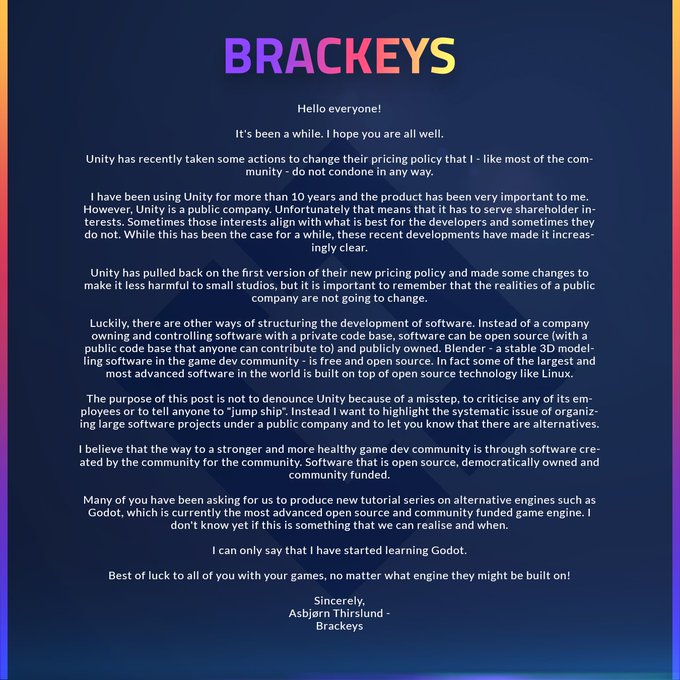Confirmed. At first I was confused about the comments. Good idea, an obvious opportunity!
Spzi
burning teslas owned by random people when it seems it would be easier to burn this fucking nazi asshole?
Because simply in practical terms, it's the other way around. There's a Tesla right next door, but only one Musk somewhere, probably not where you are. And mostly, one has personal bodyguards, while the others just sit on the road.
Offering a slight damper / correction:
This is about two things (design and ownership), which are correlated, but not identical.
Malicious design can be things like:
- Algorithms to keep people engaged
- UIs to confuse users (luring them to purchases, or making 'cancel' hard to access)
- Using intermediate currencies to make it harder to assert value
- ...
Obviously, these patterns and practices can also be applied to a FOSS instance you own. There is less incentive to do so if the profit motive is removed - which makes a huge difference.
These design patterns are fundamentally about making user numbers go up. Attract more users, keep them on your platform longer, make them leave less. And a portion of user guidance mixed in. None of that is inherently evil, to some degree even desireable, and to some extent unavoidable to offer a functional service.
Some users may expect a feed like lemmy to browse indefinitely, since they find it inconvenient to have to click to go to the 'next page'. And because they got used to this feature elsewhere. Others already see this as a dark pattern.
I just wanted to highlight how some of the malicious stuff may still be present in the fediverse, without any company involved. Here, we're kind of in charge on both sides: Each is responsible for their own user agency (like controlling your online hours, or what sites you visit), and collectively to decide what user experience we want to shape (which might include controverse patterns).
I spent way too many words on this. Mostly I agree with you! And overall, users will encounter far less malicious patterns on FOSS.
[Edit: Formatting]
Wouldn’t it be reasonable if another administration get in power and then need to purge all these positions of pro trump people?
Oh no! You have a great point for horror fans there.
I'd even say, it probably is somewhat necessary in order to resume administration. What a beautiful, postfactual dilemma:
The Reps fear an ideological, systemic witch hunt, which they use as an excuse to replace government workers. The new workers are ideologically aligned with the Reps, encouraged to assist the dismantling of non-Rep institutions and carry out the King's will above and beyond the law.
Now when votes swing the other way, the new administration kind of has to revert some of this damage to assume functioning.
Which is where the circle closes; the prophecy fulfills itself. Now the Reps have evidence for their previously baseless claims. The whole system is locked in a back-and-forth mud wrestling of replacing workers based on ideology.
So is social media, and the openness of free societies to internal (the rich owning the media) and external (foreign adversaries) tampering. Spreading misinformation, eroding trust in institutions and truth itself, poisons like that.
Many democracies are crumbling this way. We yet have to find an effective antidote.
Regardless of the voting system, there still is a worryingly large portion of voters who were corrupted to serve other's interests. And that is true to all (?) countries. That not just any two democracies fall first, but GB and US, kind of shows us that it could be anyone.
So while it is easy to look down on the fallen, or feel ashamed to be that - we're helpless in this together. Hate to end like that.
Very nice, exactly the signal The Free World needs now. Now, that the previous leader vanished in a puff of Kreml propaganda.
It's now more than ever at stake wether Ukraine can fend off the invasion (the outcome of which is another signal to autocrats eyeing future invasions, for example Taiwan, Transnistria*). It's a question.
One answer, one possible scenario is that each individual EU country feels overwhelmed to shoulder the additional burden. Or that the Union cannot muster enough support to replace the U.S. This scenario can be self-reinforcing. If it seems likely that the combined response would still be insufficient, a plausible outcome is everybody holding back, which already would favor the Russian aggression.
So this is why I want to highlight how much good news this is, because it's exactly the opposite kind of example. Literally stepping up.
*) Transnistria: Edited thanks to a comment, original wrongly said 'Tasmania'.


"The day starts at night" sounds silly because it seems to be a contradiction. But really, how else could it be?
Either, day starts at day ... but then it was already day. Or, day starts at night ... unless we come up with additional entities like dusk or dawn.
And since we haven't introduced them yet, day has to start at night, as a necessity.
Of course the actual silly thing is that it's still night right after day has started.